Wednesday, December 21, 2011
Mother and Calf Right Whale Sighted in the SE US
Saturday, December 17, 2011
Monday, October 31, 2011
Saturday, March 19, 2011
Right Whale Survey Plane to Appear at Wings Over Flagler Fly-In
 We have wanted to do this for some time. The AirCam is an important part of the Project. However, most people only get to see our plane at a distance, flying along the shoreline or circling over whales. Now, the opportunity to see the Marineland Right Whale Project’s AirCam aerial survey plane up close is coming next weekend. We have teamed up with the Flagler County Airport to bring the AirCam to the Annual Wings Over Flagler Warbird Fly-In at the airport on Saturday, March 26th from 9am to 5pm and Sunday, March 27th from 9am to 3pm. The AirCam will be on exhibit along with the equipment used for aerial survey and displays showing various aspects of the Project.
We have wanted to do this for some time. The AirCam is an important part of the Project. However, most people only get to see our plane at a distance, flying along the shoreline or circling over whales. Now, the opportunity to see the Marineland Right Whale Project’s AirCam aerial survey plane up close is coming next weekend. We have teamed up with the Flagler County Airport to bring the AirCam to the Annual Wings Over Flagler Warbird Fly-In at the airport on Saturday, March 26th from 9am to 5pm and Sunday, March 27th from 9am to 3pm. The AirCam will be on exhibit along with the equipment used for aerial survey and displays showing various aspects of the Project. $5.00 Adults 18yrs and over
$3.00 Teens 13-17 years old
$7.00 Adults 18yrs and over
$5.00 Teens 13-17 years old
Free for kids 12 and under w/Adult
Thursday, March 17, 2011
Right Whale News Available
Monday, February 28, 2011
The Whales Keep Us Guessing…Again
 Just as we thought that the season may be drawing to a close, the phone rang on Friday afternoon, 25 February, with a sighting from Surf Club, about a mile south of Marineland. To our surprise, we confirmed a mother and calf, heading SOUTH! We followed them to Washington Oaks, then to
Just as we thought that the season may be drawing to a close, the phone rang on Friday afternoon, 25 February, with a sighting from Surf Club, about a mile south of Marineland. To our surprise, we confirmed a mother and calf, heading SOUTH! We followed them to Washington Oaks, then to Friday, February 25, 2011
Another New Right Whale Mother and Calf
 The Marineland Right Whale Project’s acoustic sampling boat, on the water that day, received the whales’ location from the FWC team. As the winds calmed and the sun brightened, the curious calf and its mother came by for a close approach. The team recorded and photographed this pair over the course of the afternoon.
The Marineland Right Whale Project’s acoustic sampling boat, on the water that day, received the whales’ location from the FWC team. As the winds calmed and the sun brightened, the curious calf and its mother came by for a close approach. The team recorded and photographed this pair over the course of the afternoon.Tuesday, February 22, 2011
Where are the Whales?

The short answer to the above question is, “not where we anticipated they would be, based on past seasons.” Our most recent sightings, a humpback whale on 18 February and female right whale #3430 and calf on 19 February, were both offshore, on the 3-mile trackline now flown regularly by the AirCam. Shoreline sightings are remarkably non-existent. This reminds us of the 2008 season, when the right whales departed our area early, and our last sighting of the season occurred on 12 Feb. However, that season was the warmest of our eleven seasons and the current season has been one of our coldest. Last season, another very cold one, the whales seemed to linger in our area, not completely departing until well into March. We still have much to learn about what influences the whales’ movements. They may yet reappear, with water temperatures warming over the last several days.
Tuesday, February 15, 2011
Offshore Sightings
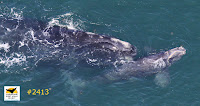 As the sightings from shore became scarce, the AirCam altered its survey track to fly a coastal, 1 nm line south, then shift east and fly a 3 nm line north. The result is a couple of sightings we would otherwise have missed. On 9 February, Jim and Joy flew this pattern and discovered right whale mother #2413 (provisional ID) and calf 3 nm east of
As the sightings from shore became scarce, the AirCam altered its survey track to fly a coastal, 1 nm line south, then shift east and fly a 3 nm line north. The result is a couple of sightings we would otherwise have missed. On 9 February, Jim and Joy flew this pattern and discovered right whale mother #2413 (provisional ID) and calf 3 nm east of  We last saw #2413 and calf on 17, 18 and 19 December. In those three days, the pair traveled from St. Augustine Pier to
We last saw #2413 and calf on 17, 18 and 19 December. In those three days, the pair traveled from St. Augustine Pier to In a pattern reminiscent of last season, when temperatures were on the colder side, the whales are around, but currently further offshore. With a warming trend between now and the end of the week, the whales could move in and be visible from shore. Plus, we are still looking for some females, #1622 and #2753, to appear with calves. The season is far from over!
Thursday, February 3, 2011
Whale Blitz a Success
 After completing the coastal survey line south of
After completing the coastal survey line south of Tuesday, January 25, 2011
Returning Right Whale Mothers
 Yesterday, 24 January, the AirCam crew of Joy and Becki discovered a mother and calf two miles south of Ponce Inlet. For several minutes, only the calf appeared at the surface, intermittently, swimming north, causing Joy and Becki to wonder if they were observing a very small yearling or an orphaned calf. Then, mom rose into view through the turbid water. She has been provisionally identified as #3430, age seven years with her first calf. We photographed her from the AirCam on 4 January in
Yesterday, 24 January, the AirCam crew of Joy and Becki discovered a mother and calf two miles south of Ponce Inlet. For several minutes, only the calf appeared at the surface, intermittently, swimming north, causing Joy and Becki to wonder if they were observing a very small yearling or an orphaned calf. Then, mom rose into view through the turbid water. She has been provisionally identified as #3430, age seven years with her first calf. We photographed her from the AirCam on 4 January in Thursday, January 20, 2011
A Large Group and a New Mom
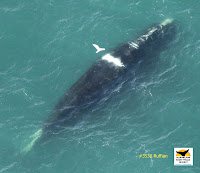 We are approaching the busy point in our typical season and the whales are turning up with more frequency. On Sunday, 16 January, the AirCam crew of Joy and Sheila confirmed a group of 13 adult/juveniles in Ormond/Daytona Beach. The
We are approaching the busy point in our typical season and the whales are turning up with more frequency. On Sunday, 16 January, the AirCam crew of Joy and Sheila confirmed a group of 13 adult/juveniles in Ormond/Daytona Beach. The 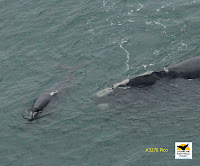 On Tuesday, 18 January, Sector 2 reported a sighting from
On Tuesday, 18 January, Sector 2 reported a sighting from Tuesday, January 11, 2011
Mother and Calf Right Whales in Ormond
Thursday, January 6, 2011
AirCam Helps Out
Our surveys began on Monday, 3 January and at 9:10 on Wednesday morning, 5 January, the

Hammock Dunes team became the first of the survey season to call in a whale sighting. Shortly thereafter, Team 3 called from
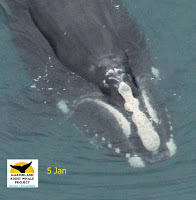
This shows the value of the plane to accurately report sightings, and underlines the importance of careful observation. The photos are of one of the whales, taken from the land and AirCam. Note the dolphin’s dorsal fin in the land photo and the unusual series of small callosities along the whale’s lower jaw in the AirCam photo. ID’s for both of the whales are pending.
On Tuesday, 4 January, a call to the Right Whale Hotline resulted in a sighting in north
to the north of the area we usually cover, the AirCam was in the vicinity on survey and gladly detoured to assist in documenting the pair. The female is tentatively identified as #3430, a seven-year-old female with her first calf. They have been sighted several times in this general area in the last week or so. We saw her as a calf in 2004 and again as a yearling in 2005.
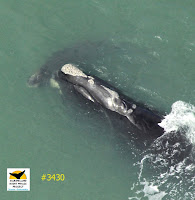
Sunday, January 2, 2011
End of Year Right Whale Sightings
The year ended on a high note with right whale sightings on the 28th, 29th and 30th of December, including two mother/calf pairs we have not seen yet this season. On 28 December, a resident of Windjammer Condo in

tentatively identified as #1604 with a calf. She is an older female, 25 years or more, and has had at least one calf before this one. The Marineland Project documented her in our area on 25 January and 28 February in 2005.
29 and 30 December were stellar weather days and we took advantage of them by flying two surveys in the AirCam on the 29th, our typical coastal survey and an afternoon flight three miles offshore. On this flight, we sighted a single adult/juvenile right on the survey line east of
On 30 December we flew a standard coastal survey and spotted a female tentatively identified as #3010 and her calf just north of the St. Augustine Inlet, our turnaround spot. This was the first time we have documented this female and it was the first sighting of her this season with a new calf. She is at least 11 years old and this is at least her second calf.

Eleven mothers and calves have been provisionally identified in the





